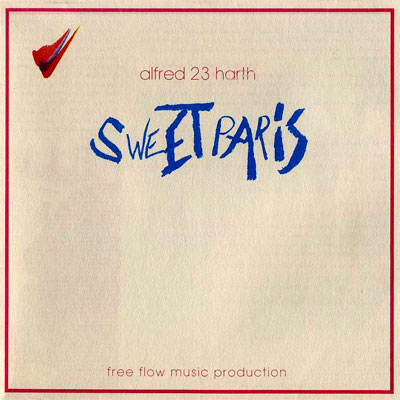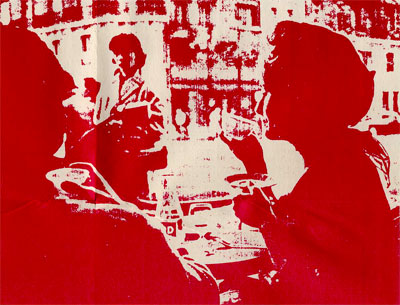



Composer, sound artist, sound ecologist and theorician Pierre Mariétan was born in Switzerland in 1935. He studied music in Basel’s Musikakademie with P. Boulez and K. Stockhausen (1961-1963) and in Cologne with B.A. Zimmermann (1960-1962) and H. Pousseur (1964-1965) – see Wikipedia article. He relocated to France in 1966 and founded the Groupe d’Etude et Réalisation Musicales (GERM), a group of musicians and composers (including Gérard Frémy and Martine Joste, piano, Philippe Blachette, violin, Philippe Drogoz, double bass, Louis Roquin, trumpet, Chantal Lemaire, cello, Jean-Yves Bosseur, rebab and flute and Bernadette Val, voice) exploring new music tendencies at the intersection of composition and improvisation. In 1970, the BYG Actuel label released an LP of Terry Riley and Mariétan’s music played by GERM members. In 1969, Mariétan became the sound producer of the legendary Atelier de Création Radiophonique founded by Alain Trutat on French national radio France Culture, a program commissioning new, original radio plays or sound documentaries by musicians, writers or composers – in a word, the closest thing France ever came to Hörspiel. In 1979, Mariétan founded the Laboratoire Acoustique et Musique Urbaine (LAMU), a think tank dedicated to the interaction of urban sound environment and architecture. It’s not clear whether he was influenced by Murray Schafer  or followed a parallel track, but, like Murray Schafer, Mariétan was interested in sound ecology and soundscape and worked for UNESCO on which sounds need to be preserved in our sound environment and which ones could be reduced. Mariétan published several books on the subject, including L’Environement Sonore, published 2005, pictured right.
or followed a parallel track, but, like Murray Schafer, Mariétan was interested in sound ecology and soundscape and worked for UNESCO on which sounds need to be preserved in our sound environment and which ones could be reduced. Mariétan published several books on the subject, including L’Environement Sonore, published 2005, pictured right.
♫ Rose Des Vents, or compass rose, was commissioned by the French government in 1981 and would take 6 years to complete through various stages. A preliminary version was premiered during a live performance in 1982 with 8 saxophonists and tape. During the following years, Mariétan gave more and more importance to field recordings and the work became an aural travelogue, “a seven-day musical happening in an urban environment” (PM). In its final version, self released in 1987 with help from GERM members, Rose Des Vents included urban and field recordings, music workshops for children, interviews, animal sounds as well as music recorded in the studio – saxophone and keyboards, mostly. The outdoor recordings come from various small cities around Paris (Cergy-Pontoise, Meaux).
During the 1980s, Pierre Mariétan worked on several projects with children as an educator, materializing in his book “L’enfant à l’écoute de son environnement” (The child’s sound environment). This experience is well reflected in the first part of Rose Des Vents (IA) with lovely, tentative music by children (see listening guide below). But it’s actually the low rumble of a barge’s engine which forms the backbone of IA and IIB. This specific sound functions as a metaphor of power, travel and home living on water, and can brings memories of childhood or tourism. Generally speaking, the sounds chosen by Mariétan for Rose Des Vents have deep psychological roots and the whole sound work is a major achievement in the field of psychoacoustics, comparable only with similar works by Annea Lockwood and Herbert Distel. If you’ve ever wondered what psychoacoustics means, listen to track #4 at around 05:00, a French horn and neighing horse duet. The juxtaposition of these 2 sounds, the proximity with the horse contrasted with the horn in the distance, combine for an overwhelming experience where the smell of the horse is almost tangible (on a good stereo).
01 Rose Des Vents – IA (25:06)
02 Rose Des Vents – IB (23:55)
03 Rose Des Vents – IIA (25:23)
04 Rose Des Vents – IIB (27:25)
with:
Pierre Mariétan, field recordings, montage
Bernard Geyer & Gérard Frémy, piano and synthesizer
Daniel Kientzy, saxophones
Gilles Laujol, sound engineer
GERM, producer
Total time 1h 41mn 49s
2xLP in gatefold, white cover, private release, France, 1987
Download (238 Mb)
. . . . . . . . . .




Rose Des Vents – a listening guide
IA
00:00 Children shouting
00:18 Speaker: “Concert d’enfants à La Péniche. Le jour” (Children’s concert on The Barge, day time)
00:30 Children playing various music instruments
01:00 Low rumble of a barge’s engine
05:15 Barge’s engine+saxophone (Daniel Kientzy)
10:20 Barge’s engine+naive electronic loop (Gérard Frémy?)
13:00 Children (?) on metallic percussion and wind instruments
16:00 Speaker: “Approche, écarte” (bring it near, put it away)
17:30 Saxophone duo ends with synthesizer sounds and loop
19:18 Speaker: “Marché aux saxophones” (The saxophone outdoor market)
20:00 Sounds from an outdoor, organic food market
21:05 Discreet saxophone and synthesizer notes in the background
24:37 A vegetable peddler: “On est parti mon kiki dans la patate, là!” (Potatoes, potatoes!)
IB
00:00 Speaker: “Trains et jardin” (Trains and garden)
00:05 Brief saxophone call, then train station environmental sounds
04:04 Speaker: “Jardin et trains” (Garden and trains)
04:40 Soprano saxophone and synthesizer notes with train station environmental sounds
08:00 Speaker: “Carillon des Etaux. Cloches et saxo” (The Etaux carillon. Bells and saxophone)
08:10 Low electronic drones with saxophones
15:00 Quiet saxophone chamber ensemble
16:00 Bird sounds
18:00 Short electronic loop
18:20 Church bell. Bird sounds
19:53 Short electronic loop. Bird sounds
20:30 Speaker: “Lointain et près” (Near and far)
22:50 Bass and soprano saxophone duet
IIA
00:00 Speaker: “Octave et trains” (Octave with trains)
00:05 Saxophone playing octaves
02:40 Speaker: “Carillon de la Gare. Cergy-Pontoise” (The train station’s carillon in Cergy-Pontoise)
02:45 Train station environmental sounds with carillon
05;00 Train station environmental sounds with low electronic drone.
06:40 Train station environmental sounds with short synthesizer melody
07:00 Train station environmental sounds with various electronic loops
10:28 Speaker: “Extraits de La Rose. Approche. Pièces 1 à 12. Marche” (Excerpts from The Rose. Approach. Part #1-12. March)
10:36 Twelve piano+saxophone duets, with occasional synthesizer or basic sound treatment, like re-recording or speed modification
24:50 Bell sounds
IIB
00:00 Speaker: “Chevaux. Echo” (Horses. Echo)
00:10 Horse paddock environmental sounds
04:55 French horn+neighing horse duet
06:25 Speaker: “Matin. Midi. Soir” (Morning. Noon. Evening)
06:35 Bird sounds
08:47 Interview with local elder from the city of Meaux, near Paris, about an old radar and sound environment in general
12:00 Bird sounds with distant planes
13:00 Powerful, static electronic drone slowly growing
15:40 French horn. Street recordings and conversations
17:50 Speaker: “Péniche la nuit. Ecoute” (A barge at night. Listen)
18:00 Low rumble of the barge’s engine. Water sounds
19:00 Engine sounds growing in intensity. Loudest sound so far
22:20 Engine sound ends. Water sounds from a canal lock or bridge
23:45 Harmonium notes
24:00 Water sounds slowly decreasing
* *
*







































